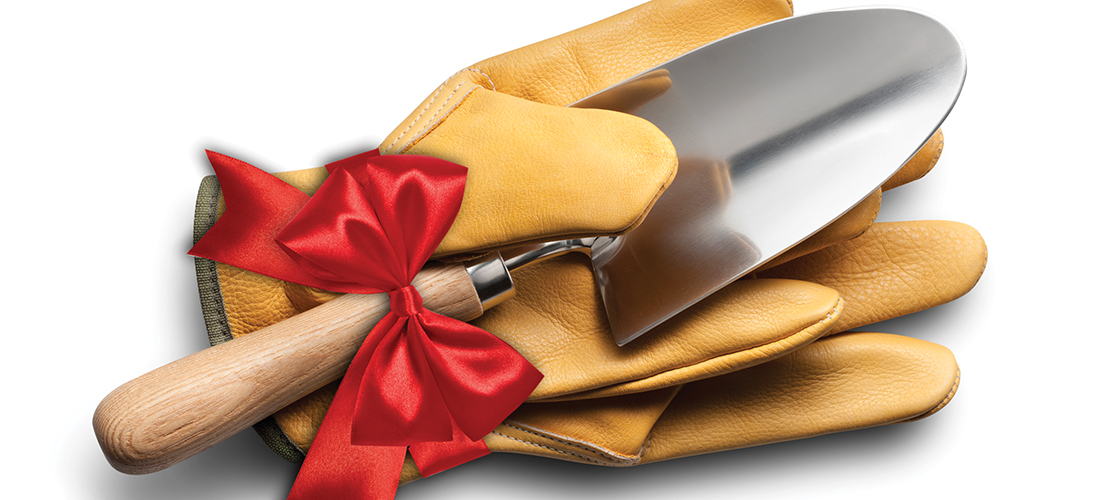
Presents for the kitchen gardener in your life
By Jan Leitschuh
Gardening is like any passion — it comes with snazzy and useful accoutrements.
If you are gifting someone with a kitchen gardening passion, your selections range from stocking stuffer to “oh, honey!” Dial your appropriate dose.
Anyone who grows vegetables loves fresh food, and handling the fruits of one’s labors is more a pleasure than a chore. Chopping, scraping, dicing, peeling, julienning — all render the raw garden product into components for a terrific meal. So, I’d put a great kitchen knife for food prep right up there with the garden hoe.
My go-to tool in a kitchen full of expensive, passed-down Henckels knives is a simple and lightweight ceramic paring knife. It’s sharp as hell, lightweight, handy and nimble, has a great feel in the hand, is tough enough to halve a squash or fine enough to peel an apple. It makes vegetable prep a delight. It’s inexpensive.
Ceramic knives are fashioned from a zirconia powder, and then fired and sharpened. If a diamond is a 10 on the hardness scale, then a ceramic knife is an 8.5. Ceramic knives don’t corrode, and they keep an edge longer than steel. Nor do they react to fruit acids. Beyond that, the indefinable, tactile pleasure of dicing an eggplant or a tough-skinned tomato with a sharp ceramic is the element that keeps me reaching for my light, white-bladed knife over and over again.
Gardener’s hands are hard-working tools, too. Exposure to mud, cold and sand is rough on hands, cuticles and nails, drying them ragged. Thorns and stickers poke holes in our tender epidermis, forcing us to get a tetanus booster (yes, it’s possible to get tetanus from a thorn stick). So, gloves are always a thoughtful gift, even as we lose the last pair in the junk drawer and wear a mismatched glove on our right hand to pull the spiny okra or cut free a thorny eggplant.
You could have a fight on your hands. A true gardener loves the feel of good soil — cool, fluffy, rich and free of rocks, sifting through the fingers. It’s an aesthetic pleasure. Unfortunately, the practice is rather hard on the hands. Most gardeners compromise, starting out in their gloves and then shucking the right one the moment a delicate task such as tying twine is required. The discarded glove lies hidden under the peppers, getting rained on and baked, until discovered, ruined, in the fall when pulling up the plants. So, the timing is right for a new pair.
A simple cotton pair from the hardware store is the first option. They are, er, dirt cheap and work for general use. They help prevent the worst effects, but can quickly become sodden when transplanting in damp spring soil. If you choose these, be rash, buy a half-dozen for cycling through the wash.
The more useful sort of glove has a waterproof barrier that keeps hands dry. The palms and fingers of a cotton glove are dipped in some sort of rubbery compound, usually nitrile, and function as a pretty good barrier. They look cool, grip quite well, and since the back of the hand is cotton and not smothered in nitrile, breathe fairly well. They also come in candy colors — turquoise, bright yellow, purple, pink, etc. — so you can buy several pairs for a stocking effect.
The most luxurious gloves are goatskin leather. For some reason goatskin is popular as a garden glove material, perhaps because it is both thin enough to be useful, soft enough to be comfortable, and tough enough to allow one to pull weeds or clip thorny things. It breathes better than the rubbery gloves. Extra little luxuries are a cotton lining, which the Brits favor, and a little drawstring adjustment at the wrist for best fit. They are still fairly cheap, $20 to $30.
A padded kneeling bench is a terrific gift, also around $20 to $30. A good one has handholds on the side to assist those trick knees in rising. Once up, you can flip it over as a little padded sitting bench.
A gift certificate to a seed company will ensure a pleasant January, flipping through seed catalogs by the fire compiling the shopping list. Sniff around to discover their favorites.
Moving up the gift scale, every gardener would find a pruner handy for snipping tough stems like eggplant, pruning grape vines or fruit trees and the like, besides general home landscape use. The gold standard here is the Swiss-made Felco 2 bypass pruners. Hardened steel, with the classic red handle, these pruners are endlessly handy. There is a notch for cutting wire. They can be kept super sharp, and clean cuts help wood heal. This is a professional grade tool. Get a hip holster while you are at it, so your gardener can feel like a boss and never be at a loss.
What Sandhills gardener wouldn’t welcome a load of really good compost? We’re not talking the “topsoil” sold in bags at the discount store but real, honest-to-goodness eggshell compost. I’ve used Brooks Contractor of Goldston, and split a dumptruck load with a friend. T. H. Blue may also have something for your giftee. But know what you are getting into. The truck needs access to your garden to dump, and you’ll need some energy to spread it and till it in.
Come to think of it, renting a strong body with a tiller for a day is not a bad idea for a welcome gift.
But back to compost. There are other businesses and barns in the area that may have compost. Call around to locally owned garden centers, ask friends, ask N.C. Cooperative Extension. And if you don’t want to deal with a large pile, it’s perfectly fine to gift a few bags of mushroom compost to dig at leisure.
Finally, we come to the “oh, wow!” gift for any gardener. That would be a small walk-in greenhouse. I’ve seen them as inexpensive as $100 (JCPenney, out of plastic) and you go up from there. My little pleasure was a sturdy plastic house called The Germinator (about $300), and it tucked into a sheltered nook with the garage on the north and the house on the west.
Because it was sheltered, it required only a few nights of supplemental heat from a portable heater with an extension cord to keep things from freezing. Black 50-gallon pickle barrels filled with water were the pillars of my back shelves and offered thermal mass. They released heat at night and absorbed it during the day. My husband gifted me a remote thermometer with a readout I put in the kitchen window so I always knew when things were too hot or too cold.
A greenhouse really needs flat ground to perform well. You also need to monitor temperature and adjust manually on these simple structures. Fancier models offer sturdier walls and more automated temperature controls.
These are the gifts that keep on giving. And, best of all, you may be the recipient next summer of some mighty fine produce. Visions of sugarplums don’t hold a candle to that first homegrown tomato. Win-win! PS
Jan Leitschuh is a local gardener, avid eater of fresh produce and co-founder of the Sandhills Farm to Table Cooperative.





